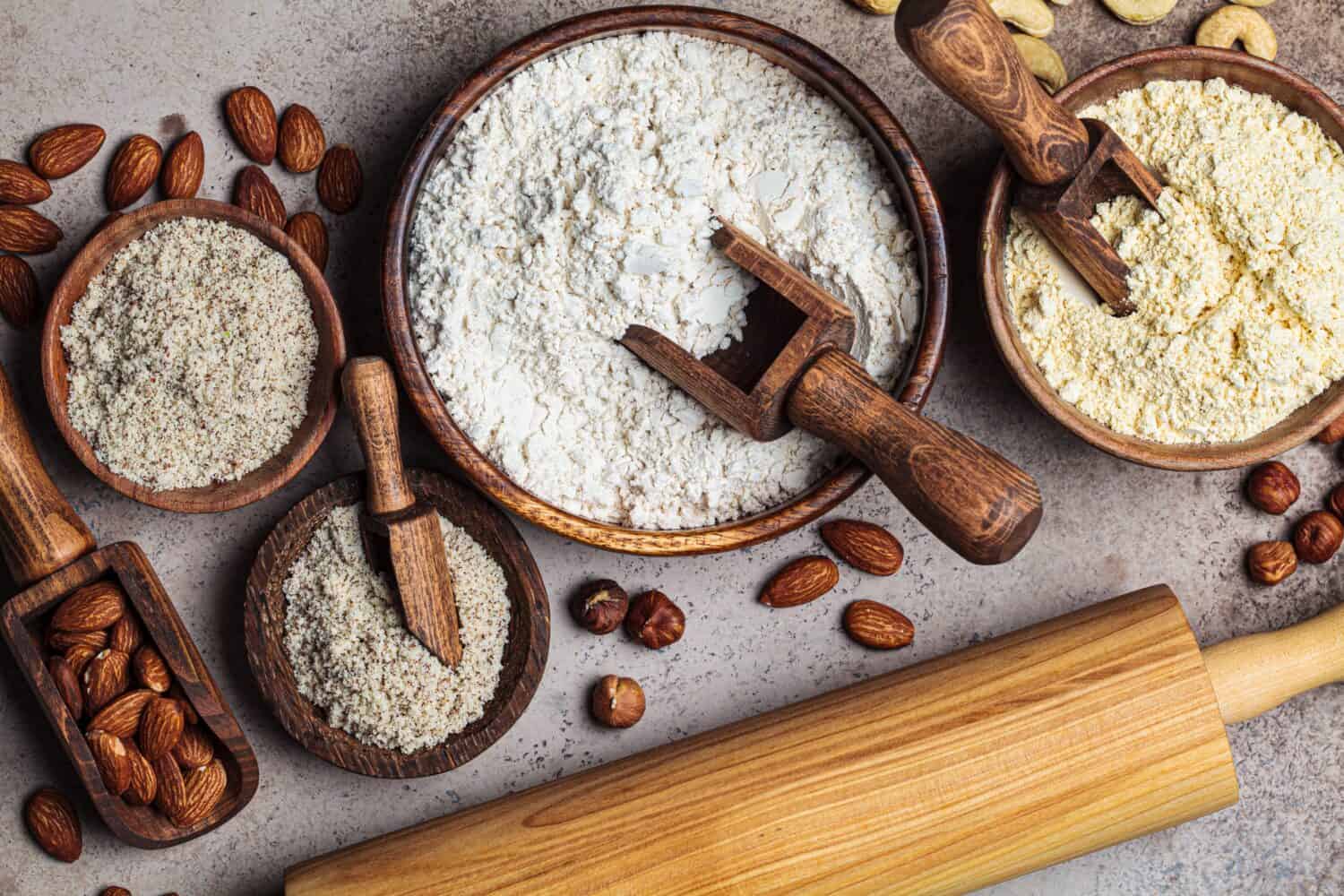Have you ever been in the baking aisle and wondered if there are any differences between almond flour vs. all-purpose flour? They’re both just kinds of flour, right? Technically, yes, however, there are some differences worth knowing about. When comparing almond flour vs. all-purpose flour, perhaps the most important difference to understand is their gluten content. While all-purpose flour contains gluten, almond flour is completely gluten-free. This is why it’s popular for anyone with celiac, or gluten-free requirements. Other things to know include the difference in fat content, taste, and the shelf life of almond flour vs. all-purpose flour. Both are great for baking. There are numerous recipes that can be made with either. Knowing these differences will help you to be more prepared for what you're making.
In this post, we’ll talk about the history and evolution of both types of flour. Learn more about how each of these flours is made, and get some recipe ideas as well. We’ll do a comparison of their nutritional profiles, and see, ultimately, which one is healthier overall. Keep in mind that, sometimes especially for baking, it’s important to understand how all your ingredients may interact. More on this in a moment. So, keep on reading to learn the major differences between almond flour vs. all-purpose flour and when to use each.
Almond Flour vs. All-Purpose Flour: What Is The Difference?
As mentioned above, almond flour and all-purpose flour differ in fat and gluten content. They also have different tastes. Almond flour comes across as slightly nuttier than the subtler taste of all-purpose flour. The two also differ in terms of their shelf life. The way that all-purpose flour is milled and processed increases its shelf life significantly. Let’s get into the details of all these.
What is Almond Flour?
Starting off with almond flour, which comes from, you guessed it, almonds. Almond flour is made by soaking and boiling the nuts and then grinding them up before sifting them. This creates fine powdery almond flour as opposed to an almond meal, which is just the nuts ground up. It is actually considered one of the healthiest flours. Almond flour has a high healthy fat content, lots of fiber, calcium, and protein content, as well as E vitamins. It also happens to be low in carbohydrates and is paleo and keto-friendly.
History And Origin Of Almond Flour
Almonds have been around for a very long time. There are mentions of them in the Old Testament and traces of their origins in the Middle East. It was originally grown in areas like Syria and Turkey. Through trade routes and imperialism, the almond crop made its way to Europe and Africa. Evidence would suggest that even in the times of its origin, people would grind up almonds to make a meal or paste. These could be used for cooking and baking. This flour was actually introduced via Italy to the rest of Europe. It was popularized by an almond flour cookie by the name of Maccherone. It became popular throughout Europe, and in their modern iteration, they are known as macarons (via Spiceography).

Almond flour is made by blanching almonds so their skins come off before grinding them into powder.
©iStock.com/Elenathewise
In recent times, more research and medical understandings of celiac disease and gluten sensitivity. This created a resurgence in the use of almond flour. So, while it’s been around for a very long time, almond flour is once again considered a trendy, health-conscious ingredient to use in cooking and baking. Read on to learn how this flour is made as well as to get some gluten-free recipe ideas.
How Is Almond Flour Made
The rundown of creating almond flour requires three to four pretty simple steps. Firstly the almonds are boiled, or blanched. This process that not only cleans them but also removes the skin of the almond. Almond flour will appear quite yellow-beige in appearance. This Is because it’s completely devoid of the recognizable brownish skin of a whole untouched almond. Next, the blanched, skinless almonds are ground up into a meal. If you were just aiming to make almond flour, the process would end here. Almond flour is quite fine in nature. To get this way, it has to go through a process of sifting to get the larger pieces out. Once this is done, you can ensure a fine, powdery consistency in the final flour form.
Popular Uses For Almond Flour
There are numerous recipes that use almond flour or can be made with almond flour. Its healthy fat content will make baked goods moist. And its nutty flavor can add a wonderful layer to all kinds of sweet and savory recipes. Baked goods are one of the most popular uses for almond flour. Although, it can also be used for breadding meats, and in other gluten-free recipes. Check out some of these great recipes that utilize almond flour:
- Persian Almond Flour Cookies
- Joconde Cake
- Mixed Berry Crumble With Oats and Almonds
- Almond Crust Pizza
- Keto Chicken Parmesan
What Is All Purpose Flour?
Onto all-purpose flour, which is made from milled wheat. It is not whole-grain flour. This is because the outer layer (the bran) and the middle of the wheat grain (the germ) are removed. This leaves only the middle layer, known as the endosperm. The endosperm is full of protein and carbohydrates, but has far less fiber without the other two layers of the whole grain. The reason this milling happens is because the starchy endosperm has a much longer shelf-life than the full-grain. It also removes a lot of the nutrients, healthy fats, and antioxidants contained in whole wheat grains. All-purpose flour, as the name would suggest, is very all-purpose. It can be used in baking and cooking. And also as a thickening agent, in sauces, soups, and stews. The gluten contained in all-purpose flour is a predictable agent for rising baked goods (via Michigan State University).
History and Origin Of All-Purpose Flour
Similarly to almonds, wheat has long been a staple crop in many different civilizations. The process of harvesting and milling wheat grain into flour dates back to ancient Rome. It also existed In Egypt and the societies of Mesopotamia. The ancient Romans used stones to smash the wheat grain apart. The Industrial Revolution replaced older techniques of grinding and milling the flour by hand. Instead, huge machines were created to sift and separate the whole wheat grain into its separate parts (via Relish). The continued evolution of processing techniques and machines grew the kinds of flour that could be milled. With the help of industrialization and invention, we come to the modern-day iteration of all-purpose fine white flour. This Is the kind you can find at the grocery store today.

All-purpose flour is a form of plain wheat flour. Only the endosperm of the wheat grain is left in this flour.
©Billion Photos/Shutterstock.com
How Is All-Purpose Flour Made
All-purpose flour creation goes through several stages in the process of harvesting and milling into the final product. Wheat crops are harvested and sent to a mill to test qualities including weight, protein content, and impurities that need to be removed. It is cleaned to remove any dirt and dried in silos before the next step of the process. The wheat is put into a conditioning bin with water which softens the bran exterior, making it easier to mill for the endosperm inside. Next up is the process of blending known as gristing, where different types of wheat are mixed to create the quality of mixture needed for a particular flour type. This blend goes through machines that split the wheat open, separating the bran and the germ from the endosperm. These endosperm particulars are further milled into fine, all-purpose flour (via Fab Flour).
Note that you can find both bleached and unbleached all-purpose flour in most baking aisles. While all-purpose flour doesn’t have that much of a taste, the bleached version is as plain as can be. According to Martha Stewart, bleaching the flour creates a soft texture and consistent coloring when it's used in cake baking. Unbleached flour still has some of the coloration and particles of the wheat grain and tends to hold its structure better in baking projects like pizza dough, bread, or biscuits. Also, you should never use self-rising flour as a replacement for all-purpose flour.
Popular Uses For All-Purpose Flour
As the name suggests, all-purpose flour can be used in all kinds of ways. From crusts and breads, as a thickening agent, or in sweet baked goods, check out these recipes that use all-purpose flour as a major ingredient:
- Apple Dump Cake *substitute almond flour for regular flour to swap these recipes!
- Apple Fritters*
- Butternut Squash and Goat Cheese Galette
- Buttery Pancakes with Lemon and Sugar
- Matzo Ball Soup
- Blackberry Crumb Muffins
- White Chicken Pot Pie
- Mendient Tart with Dark Chocolate Ganache

All-purpose flour
andalmond flour can be used to make all kinds of tasty treats and baked goods.
©GreenArt/Shutterstock.com
Nutritional Value of Almond Flour vs. All-Purpose Flour
Between almond flour vs. all-purpose flour, almond flour is the healthier option. It is lower in carbohydrates, higher in healthy fat, and also has great proteins, fiber, vitamins, and minerals. It’s good for your blood sugar levels, gluten-free, and has links to lower cholesterol and blood pressure levels. All-purpose wheat flour is rich in carbohydrates which means it’s a good source of energy, and it also has some amount of fiber, protein, vitamins, and minerals. Its accessibility and versatility make it an easy option, but that does not mean it’s the healthiest option. All-purpose flour simply does not provide the same nutrients as almond flour, though it does have fewer calories (via Healthline).
Possible Alternatives To Almond Flour And/Or All-Purpose Flour
There are lots of kinds of flour. If almond isn’t to your taste, and you’d like to try something other than all-purpose flour, you’ve absolutely got options. There’s chickpea flour, rice flour, and coconut flour. Try buckwheat, oats, quinoa, yellow pea, and millet. Do some research to see how any one of these may affect a particular recipe, but baking is all about experimenting, so why not give some alternative flour options a go? Happy baking/cooking/everything involving flour!
The image featured at the top of this post is ©Nina Firsova/Shutterstock.com

